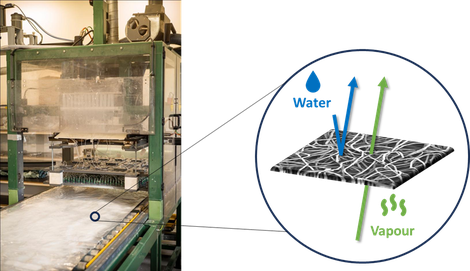Electrospinning as a new coating technology for various functional applications
Electrospinning is a technique in which a layer of very fine nanofibers is produced. This can be deposited as a coating on all kinds of carriers or used as a stand-alone membrane. The nanofibers can be common plastics, as well as bio- or ceramic-based. Some important properties of the electrospun layer are its microporous structure and large specific surface area. This makes it an ideal material to use in products that require a large physical contact. Examples include catalysts, sensors, medical applications, filtration and water-repellent vapor-permeable coatings.
For example, CTSE is working on electrochemical water treatment, among other things. Here we coat ceramic electrospun nanofibers on a carrier. The nanofibers are functionalized to exchange ions. The complexes obtained have better efficiency than commercially available alternatives. Nanofibers can also have great added value for composites. Glass or carbon fibers coated with rubbery nanofiber layers give composites that are much more resistant to damage such as delamination and impact.
Another example is making water-repellent but vapor-permeable membranes for outdoor applications, among others. Thanks to the nanofiber layers, a large water column is achieved without the need for toxic chemicals containing fluorine.

Electrospinning thus offers numerous opportunities for product innovation. CTSE has equipment and knowledge available to assess coating function as well as resistance and mechanical properties. For water repellency, for example, we can determine water column, contact angle and water vapor permeability. For other applications, we can then verify antistatic, stain or fire-resistant properties. We also evaluate chemical resistance, temperature, moisture and UV resistance. The coating is for example visually assessed after this aging for presence of cracks, blistering, peeling and color change. Pull tests, crack tests and/or peeling tests can also be performed before and after aging. Advanced techniques such as dynamic mechanical analysis (DMA) and electron microscopy (SEM) in turn offer the possibility to study cracking and delamination, among other things, in detail.
Acknowledgments
Waterproof fabric photo by Anh Nguyen on Unsplash
Contact
Prof. dr. ir. Karen De Clerck (Karen.DeClerck@UGent.be)